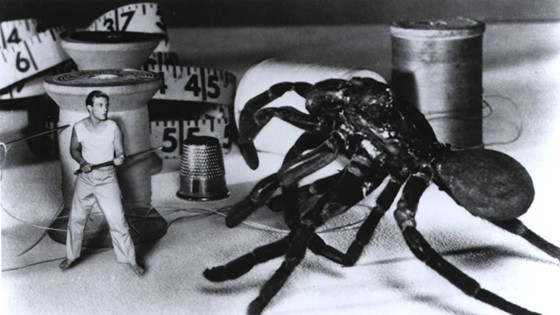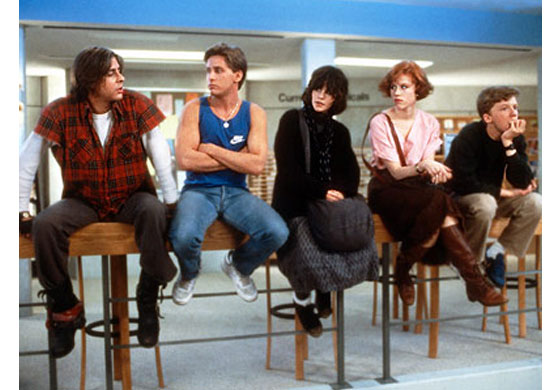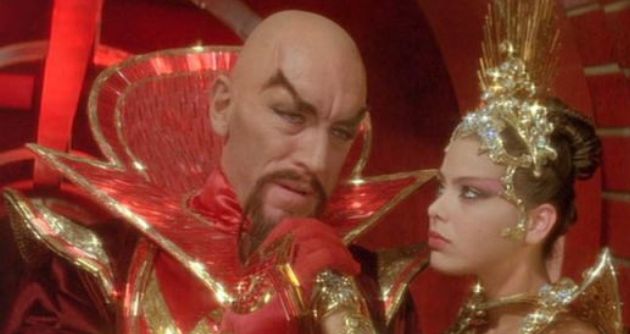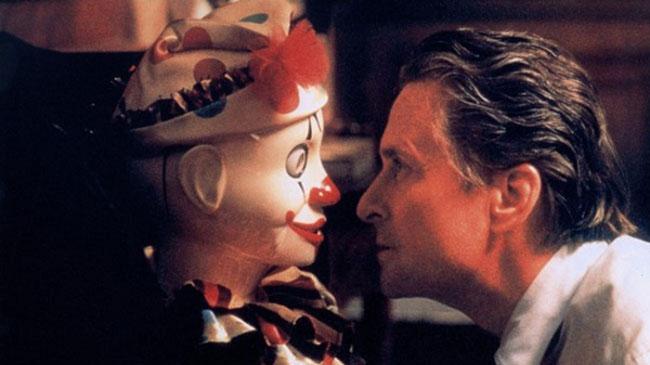6. Ant-Man – The Incredible Shrinking Man

The world of genre and pulp fiction always has a lot of cross-pollination. Ant-Man and The Incredible Shrinking Man are both sci-fi stories about humans shrinking to the size of an ant. Where they differ is how they choose to use this concept.
Sci-Fi and horror legend Richard Matheson adapted his own novel when making The Incredible Shrinking Man. It tells the story of Scott Carey who, for no discernible reason, begins to shrink, unstoppably. Scott’s lifeline is now in direct correlation to his reducing height.
Made even shorter when he finds himself lost in his basement and defending himself against a tarantula. By changing Carey’s perspective Matheson shows that a lot of humanities power comes from their height. From the perspective of an ant an ordinary suburban basement becomes a prehistoric wasteland where everything is either an obstacle or a threat.
Ant-Man however does almost the exact opposite. Of course when Scott Lang (note the same first names) first puts on the suit he finds himself in a sequence that could have been taken straight out of The Incredible Shrinking Man (surfing on the waves in a bath tub, tripping over the needle of a record player), but as this is also a super-hero movie Scott’s new perspective opens a world of opportunity not threat. And of course Ant-Man’s powers are but one element of a wider story, they become a means-to-an-end rather than the whole narrative.
The Incredible Shrinking Man is the more solid film certainly, but it also belongs to a simpler time of genre cinema. It’s use of giant sets and practical effects are quaint and still charming, but it’s a film that does what it says on the tin.
The super hero genre allows for more complex story lines which, done well, create amazing results. However in the case of Ant-Man, by expanding the scope of the narrative, they sought to build on sci-fi tropes we have seen before, unfortunately in doing so they lost some of the wonder that made them enjoyable in the first place.
7. Doctor Strange – Paprika

Doctor Strange often gets compared to Inception. And while both films do focus on other realities (one in dreams and the other in a bona fide multiverse) there’s only really one sequence that they both share in common: the folding cities. Watching New York fold into itself is spectacular and Doctor Strange’s ability to traverse the moving buildings follows the same visual logic as Nolan’s film. However the overall narrative seems closer to Satoshi Kon’s anime Paprika, itself an inspiration for Inception.
Inception tells one story, the equivalent of a bank heist, within the world of dream manipulation. Whereas Paprika concerns itself by creating a world born out of dream manipulation. Doctor Strange was used to introduce a new character but also to introduce a world-changing factor into the MCU: the existence of magic. The whole point of the movie is to reveal to audience’s that all they thought they new about this world was wrong. Now every situation that follows this film (and lead up to it) is understood to have happened in one dimension of many.
Paprika does focus on individual characters as they explore their own dreams; either for personal gain, political dominance, or even just simple pleasure. The point of the movie is to demonstrate a universe in which we all share in the experience of living in multiple realities of dream and waking life; of public and private; of on-screen and online personalities. We are all multi-faceted and we can take comfort in this unity.
The role of Doctor Strange in his film is not to complete one task but rather to accept that he is not as exceptional as he previous thought. He exceeded in one world (medicine) of many, and now he has a responsibility to find his place amongst the many who protect the multiverse.
8. Spider-Man: Homecoming – The Breakfast Club

The MCU’s Spider-Man is so obviously inspired by John Hughes movies they actually include clips from Ferris Bueller’s Day Off in the scenes where they are homaging Ferris Bueller’s Day Off. The Breakfast Club, one of Hughes’ most beloved and emotionally charged films may seem an unlikely inspiration for a usually action heavy Marvel movie.
However this current version of Spider-Man seems to concern itself with super-hero antics second, and the trials of Peter Parker first. One of the most affecting aspects of The Breakfast Club is the way it demonstrates how the kids in detention have almost no control over their lives. They are caught up in social pressure, parental expectations and even threats from adults. The teacher running their detention almost treats them like prisoners.
Peter spends much of the film in the shadow of Iron Man, to the point where his happiness seems dependent on Stark’s approval. Stark has ultimate power over him in that he can take the Spider suit away whenever he wants. Peter’s main character arch in the film, like the Breakfast Club, is to prove to the adults in their lives what they are capable of and that they have been underestimated.
The Vulture is arguably one of Marvel’s most sympathetic villains; a blue collar worker who had his opportunities routinely stolen from him by the rich and the powerful. However, following the best scene in the film when Vulture discovers Peter’s identity, he doesn’t adjust his behaviour to the fact that his enemy is now a kid. Instead he sees Peter the same way he sees all super-heroes and treats his interference as a threat to his way of life.
In a similar way to the teacher in The Breakfast Club; his reaction to Bender is almost sadistic, it’s clear that he sees him as a threat and not as a child. Peter however is able to see the Vulture as both a villain and Liz’s Dad, someone who deserves to be stopped but not killed. It is this ability to see the world as it is not as they’d like it to be that sets Peter Parker and the Breakfast Club apart from the adults in their life.
9. Thor: Ragnarok – Flash Gordon

Being honest, Jack Kirby is probably the main connection between these two films rather than any one cinematic technique or theme. Kirby was the main inspiration for Ragnarok’s aesthetic and he was arguably the most influential comic book creator of the 20th century so he will have had some influence on adapting the Flash Gordon strip.
Kirby’s colours were always perfectly well judged bringing an incredible life to each scene (something that Ragnarok and Flash Gordon have in spades). He also perfected the fish out of water hero, with many of his characters have to adjust to unusual situations (pretty much the main aspect of each film’s lead character).
Taika Waititi is a director who can take something old and somehow manage to breath new life into it. His influences are so many and varied we could have picked so many other films to compare Ragnarok too. However he has spoken the most about how much fun he tries to bring to set.
You can’t watch Flash Gordon now and take it seriously, it’s too ridiculous and too over the top. But Waititi still sees value in that, by officially making Ragnarok a comedy the film greatly benefits from existing in the world of the ridiculous and the over the top. It’s a brilliant way of saving a character who was getting stuck in the realms of Shakespearean drama.
That’s not to say that Waititi is incapable of depth. Flash Gordon is so over the top because we can’t believe in that type of heroism any more. Gone is the idea that an every man can magically triumph over the forces of evil and manage to get home all within a comfortable running time.
Thor thinks of himself as such a hero but in moments of pathos we learn that is only because he doesn’t know how to be different. He acts tough but he still feels the loss of his father and is still unable to save his homeworld. Using comedy to make us laugh and simultaneously reveal hidden depths is what makes Waititi such an impressive filmmaker because it allows him to breath new life into the already fantastic work that was made before him.
10. Captain Marvel – The Game

Set in the 1990s Captain Marvel had plenty of ‘90s references to keep us happy. However a case could be made that it took influence from one particular person who emerged during the decade; David Fincher. Fincher’s films often revolve around ideas of trust and hidden truth. His characters are often detectives or obsessives, concerning themselves with the darker sides of humanity. Captain Marvel never goes to the same places that Fincher does but it does have an entire cast of characters who can shape-shift into anything they want. With such a distinct lack of trust in the air it’s hard not to see the comparisons.
Fincher’s The Game follows a wealthy billionaire who is given a bizarre series of clues and encounters, as the story continues it becomes clear he can no longer tell when he’s in the real world or when he’s in the game. Carol Danvers is introduced to us as a loyal soldier in the Kree empire. It’s only through flash back that we discover her truth to be a lie and it opens up a far more sinister gaslighting plot.
We discover that Carol has been brainwashed into following orders which prevented her from ever achieving her full potential. In The Game our main character must learn to let go of himself and embrace the world around him. The two films work as the antithesis of each other. Maybe because the world felt so great back then, but whatever the reason it’s clear that the 1990s was not a period for trusting people.